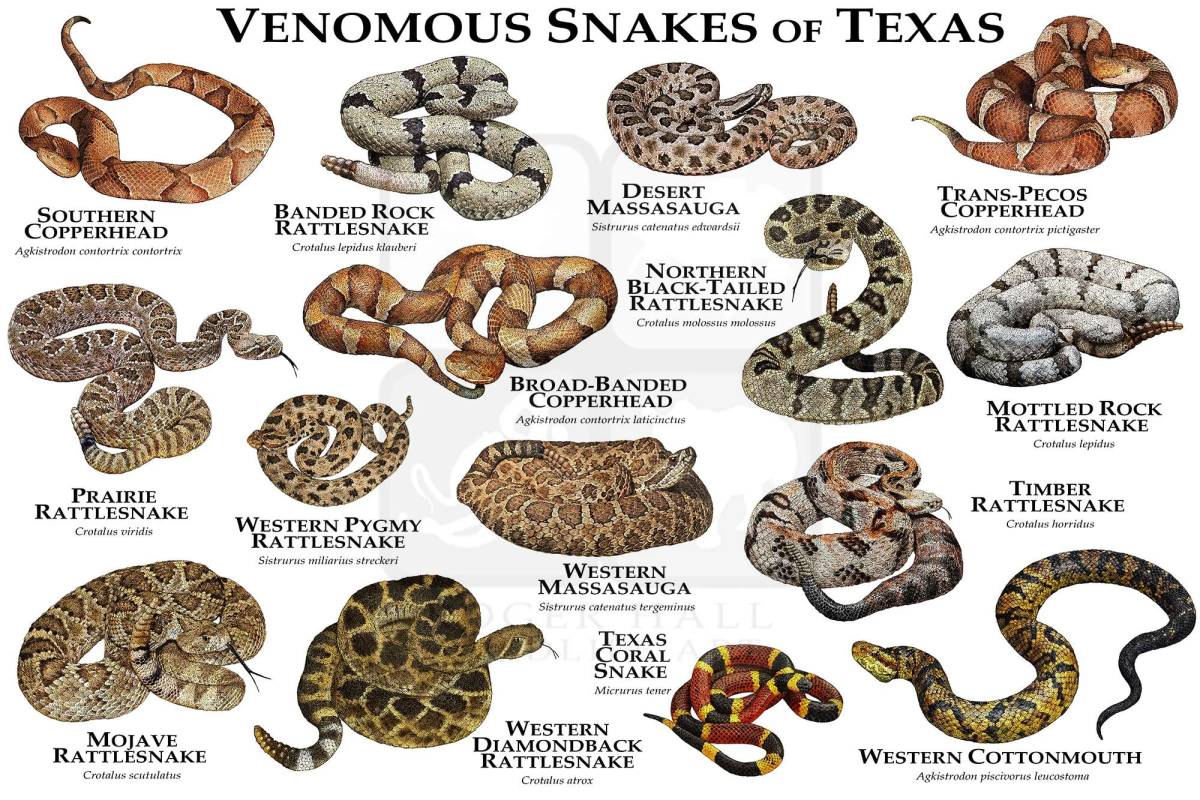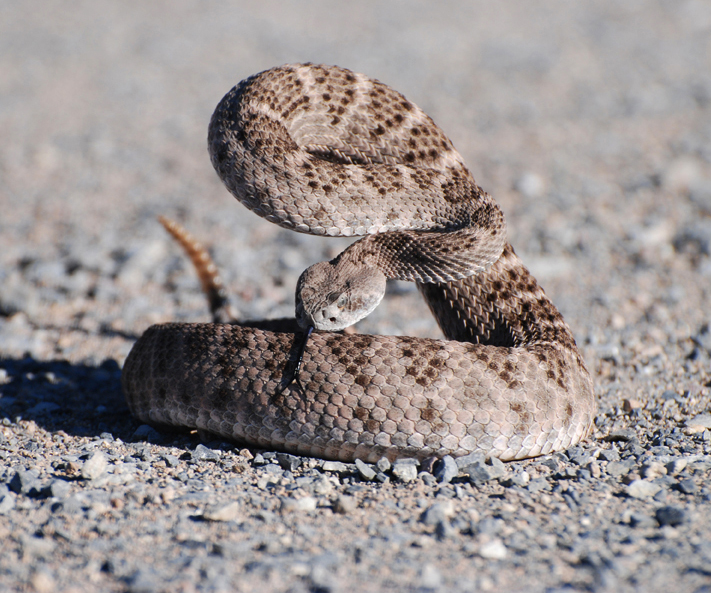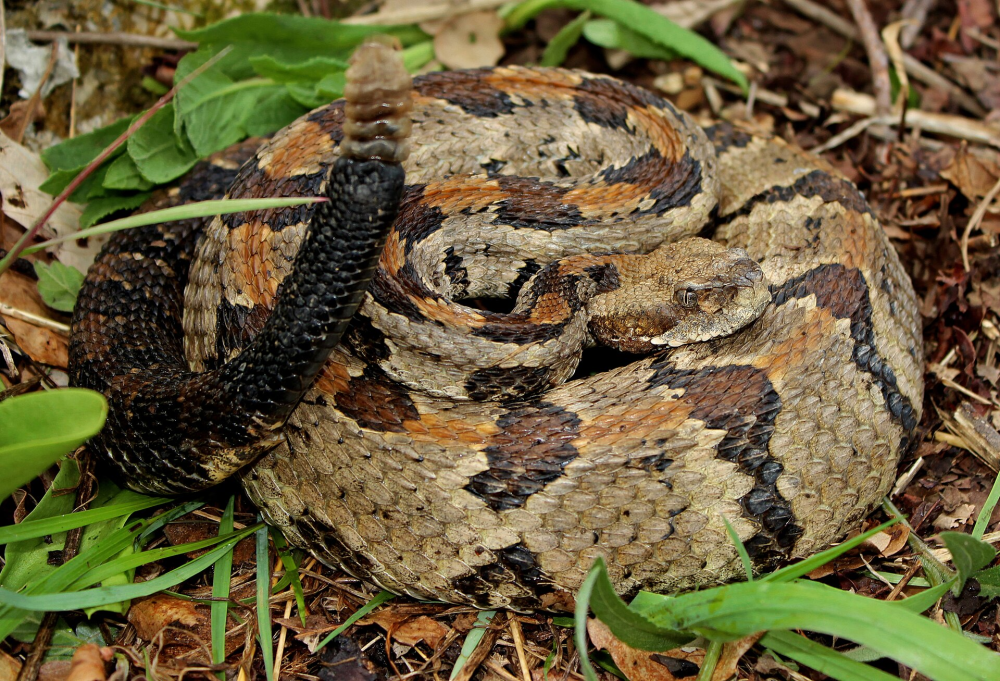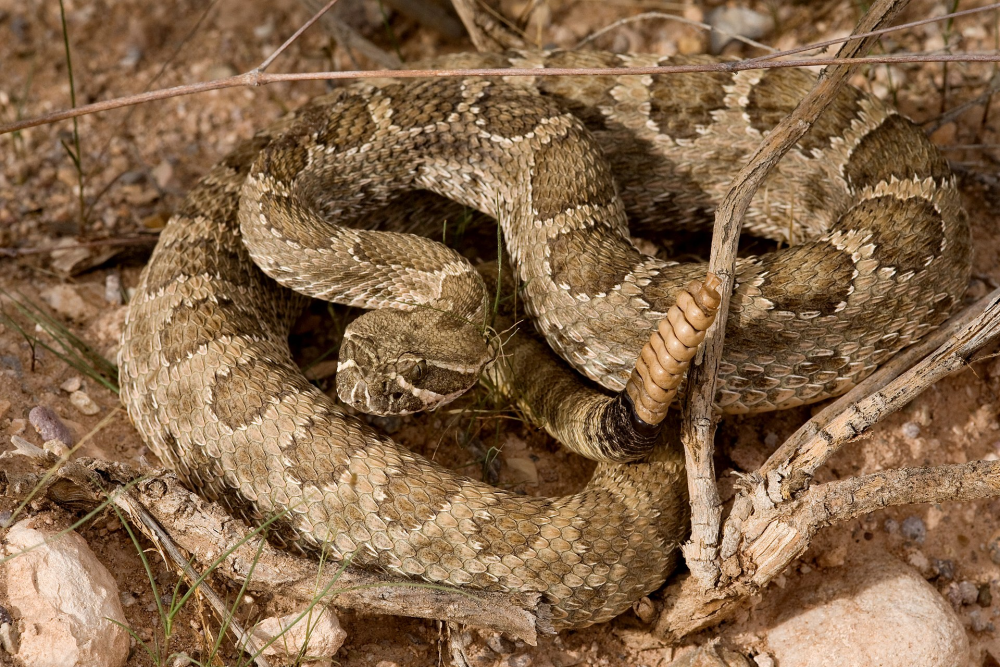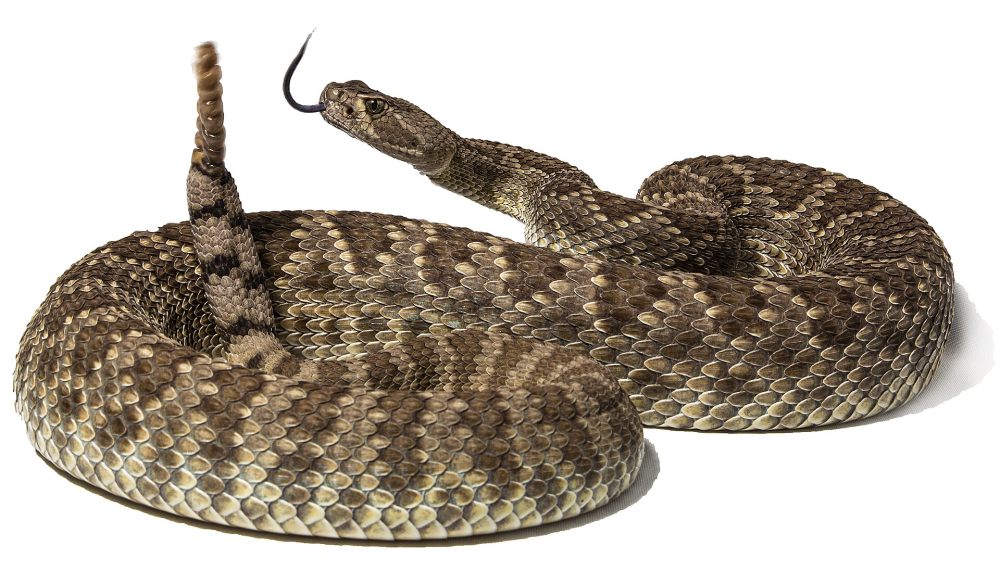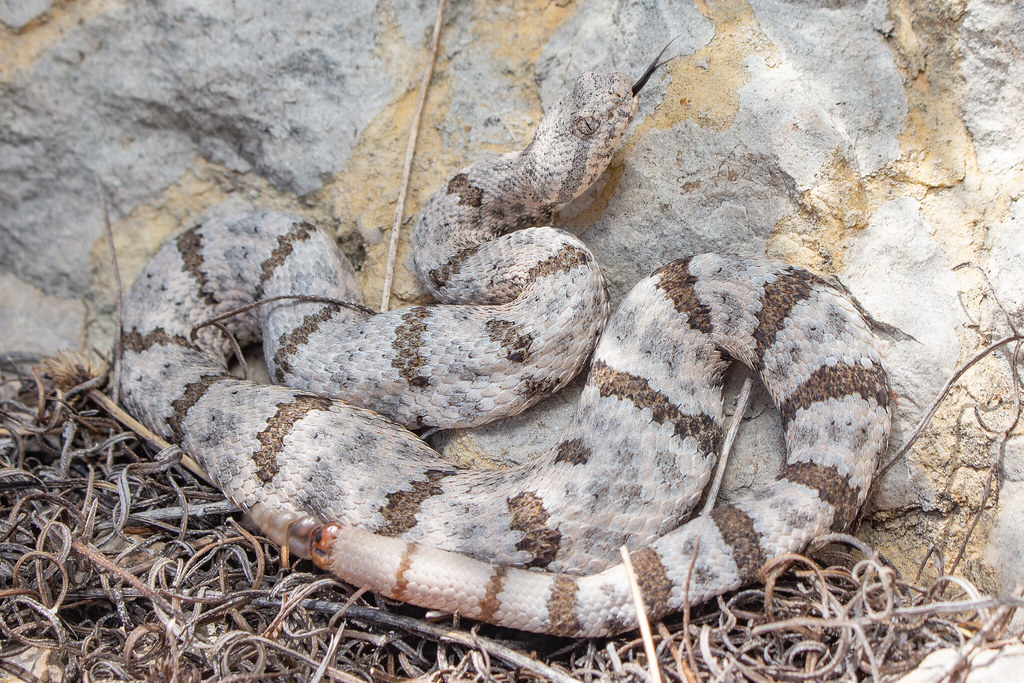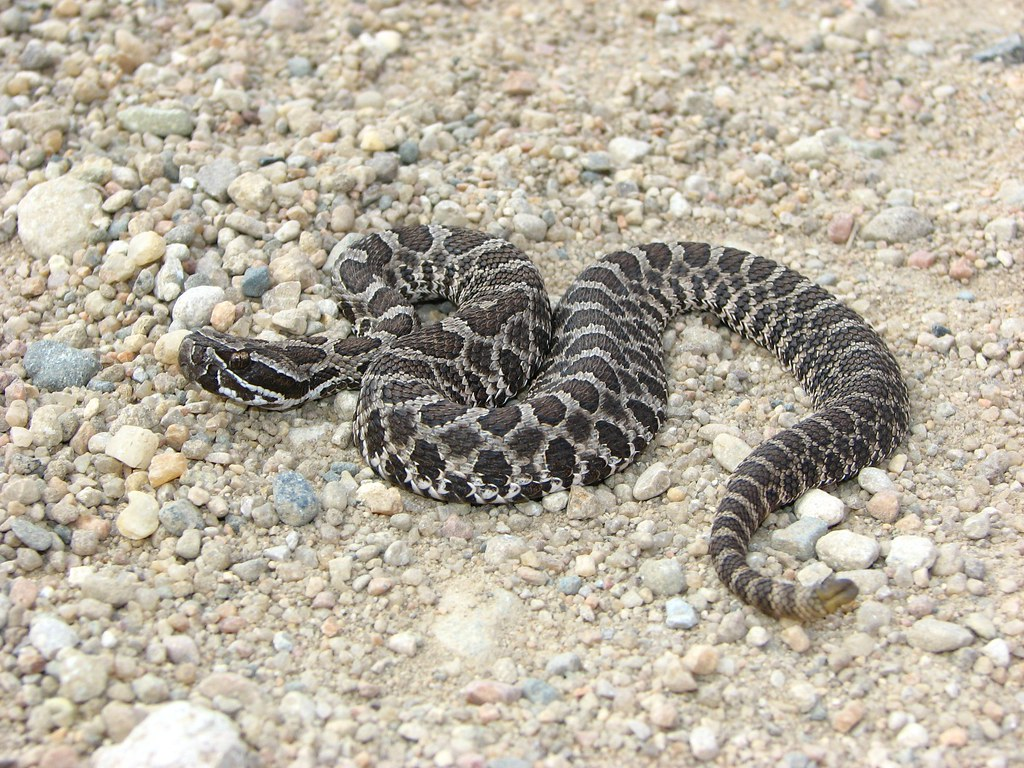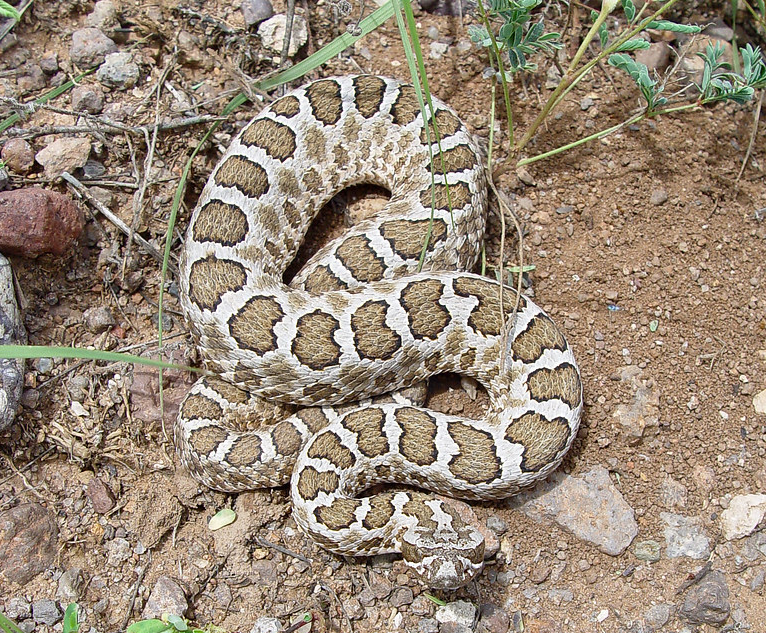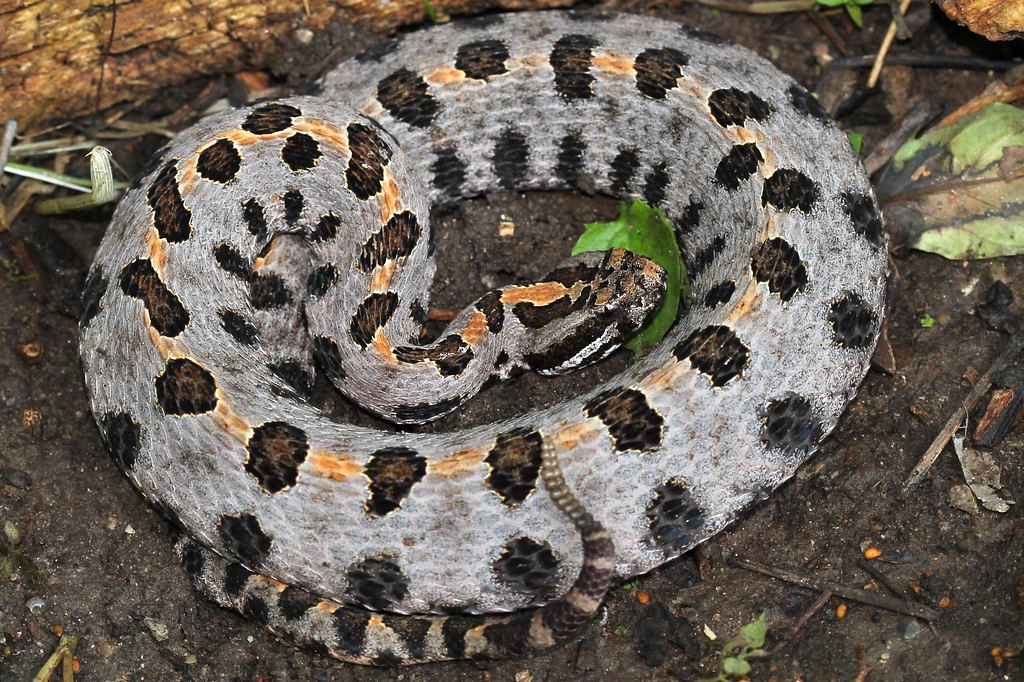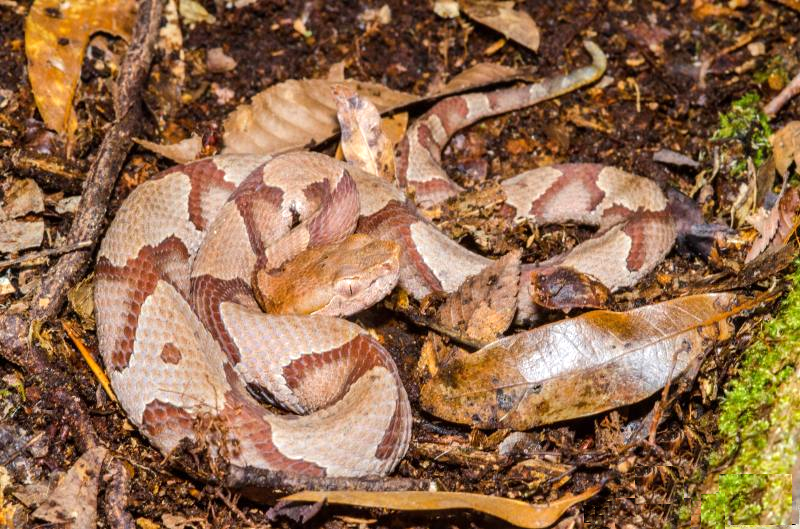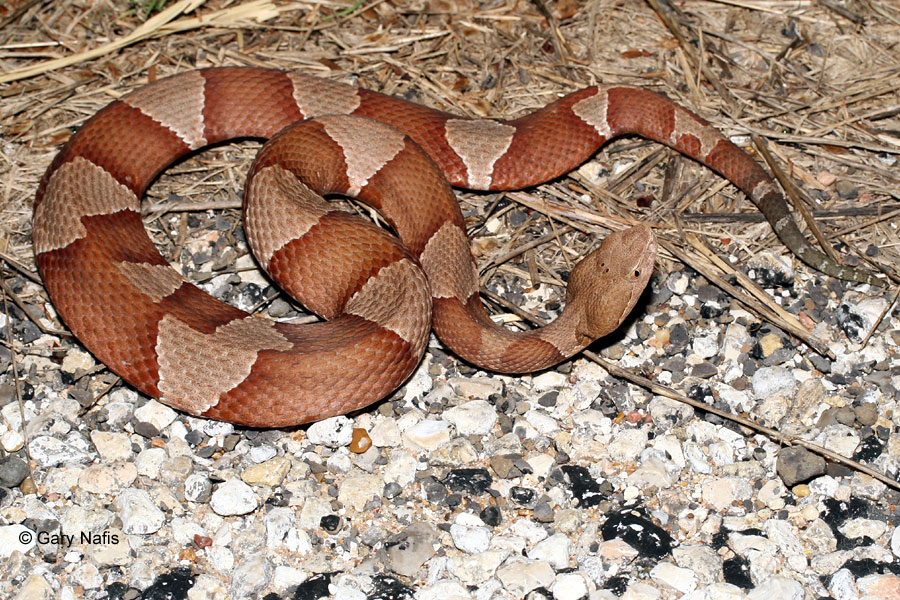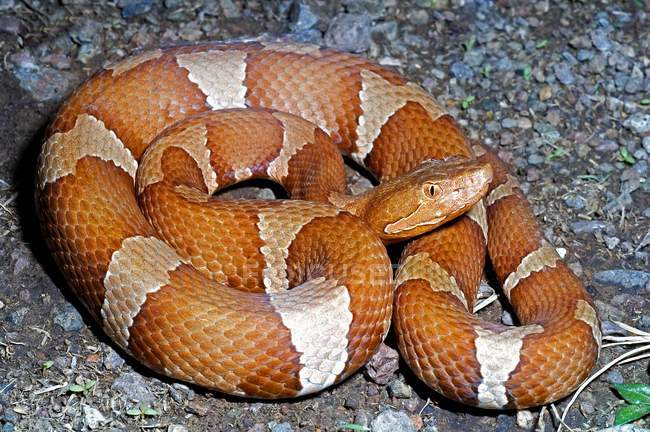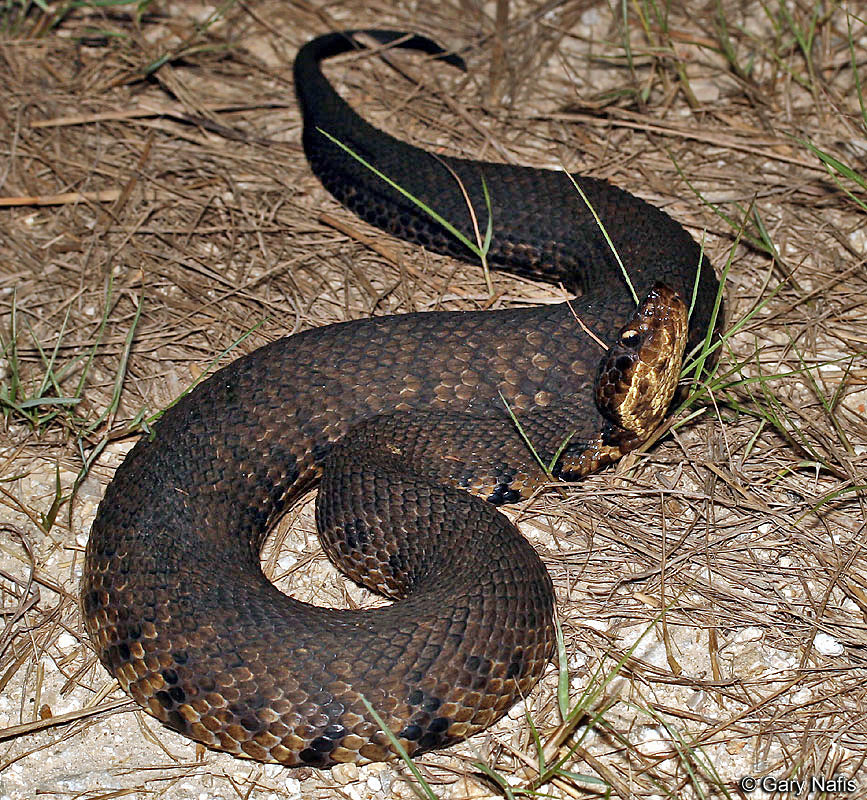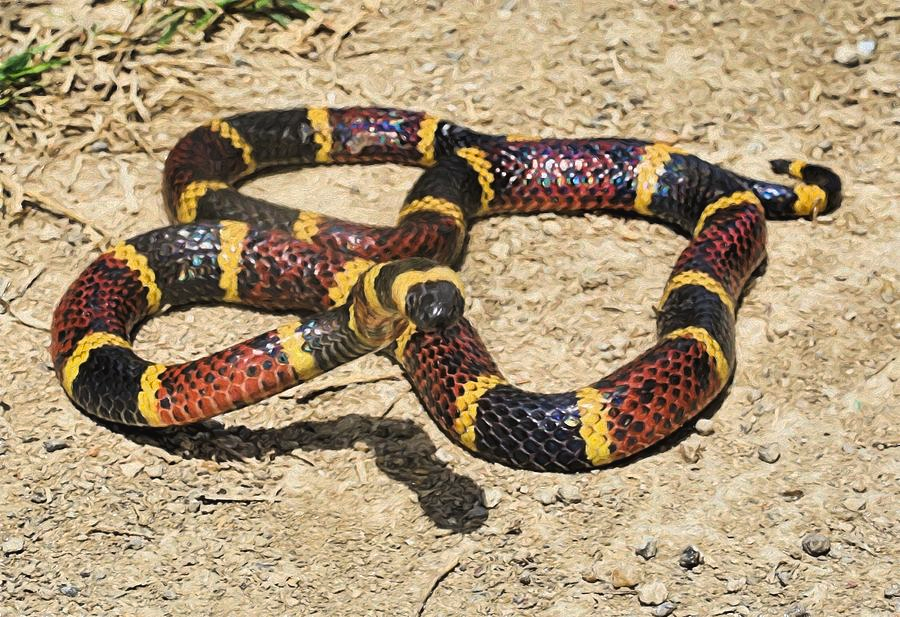Quick-Reference Overview (Four Groups)
- Rattlesnakes (Genus Crotalus and Sistrurus) — Western Diamondback is most widespread; others are regional (Panhandle, Hill Country, Trans-Pecos, Big Bend, Pineywoods). All have heat pits, triangular heads, and a tail rattle (massasaugas/pygmy have tiny rattles that sound like a buzz).
- Copperheads (Agkistrodon contortrix) — Three subspecies in Texas (Southern, Broad-banded, Trans-Pecos). Hourglass crossbands; superb camouflage in leaf litter.
- Cottonmouths / Water Moccasins (Agkistrodon piscivorus) — Semi-aquatic pit viper of East/Central Texas wetlands and slow waters. Gapes to show the white mouth when threatened.
- Texas Coral Snake (Micrurus tener) — Secretive elapid with red–yellow–black rings (yellow touches red). Small head, round pupils, smooth scales; potent neurotoxic venom, but bites are rare.
Seasonality & Timing: Most active spring through early fall, especially dawn and dusk in warm weather. In summer heat, they rest midday; in winter, activity is greatly reduced or snakes den.
Species-by-Species Field Notes
Photo tips: For web use, pull high-resolution, properly licensed images (e.g., Wikimedia Commons/TPWD). Include alt text describing distinctive ID marks.
Rattlesnakes (Pit Vipers)
1) Western Diamondback Rattlesnake (Crotalus atrox) — Statewide except far East Texas
ID: Brown/gray diamonds along back; bold black-and-white banded tail; large triangular head.
Behavior: Stands ground if surprised; defensive rattle before striking; rodent-control specialist; often near rocky cover, arroyos, prickly pear flats, barns/outbuildings.
Where you’ll meet it: Desert scrub, grasslands, brush country, ranch edges, road cuts.
2) Timber Rattlesnake (Crotalus horridus) — East Texas & Pineywoods into parts of Hill Country
ID: Tan to gray with dark crossbands; rust dorsal stripe common.
Behavior: Generally shy; prefers forested slopes and bottomlands; strong climber.
Where: Mature forests, bluffs, rocky ledges, deep leaf litter.
3) Prairie Rattlesnake (Crotalus viridis) — Panhandle & western plains
ID: Greenish/gray with rounded dark dorsal blotches; slender for a rattler.
Where: Shortgrass prairie, rimrock, prairie dog towns.
4) Mojave Rattlesnake (Crotalus scutulatus) — Extreme West Texas
ID: Similar to western diamondback in pattern; usually greener hue; narrower white/black tail bands.
Where: Desert basins and uplands in the far Trans‑Pecos.
5) Black-tailed Rattlesnake (Crotalus molossus) — Hill Country into West Texas
ID: Olive to gray with darker blotches and a solid black tail.
Where: Limestone hills, rocky canyons, oak–juniper slopes.
6) Mottled Rock Rattlesnake (Crotalus lepidus lepidus) — West Texas mountains
ID: Light gray/cream with dark crossbands and mottling; blends perfectly with limestone.
Where: Talus slopes, rocky ledges, sky island ranges.
7) Banded Rock Rattlesnake (Crotalus lepidus klauberi) — Extreme western tip of Texas
ID: Greenish‑gray with bold dark bands; more limited Texas range than mottled form.
Where: High-elevation rocky habitats near New Mexico line.
8) Western Massasauga (Sistrurus catenatus tergeminus) — Central/north-central TX
ID: Small, light gray with brown oval blotches; tiny rattle sounds like a faint buzz.
Where: Prairie grasslands, marsh edges, sandy flats.
9) Desert Massasauga (Sistrurus catenatus edwardsii) — Trans‑Pecos, western Panhandle, lower Rio Grande Valley
ID: Paler, smaller, more slender than western massasauga.
Where: Arid grasslands and desert margins.
10) Pygmy Rattlesnake (Sistrurus miliarius streckeri) — Localized in far East Texas
ID: Very small rattlesnake with subtle rattle; gray with dark blotches and an orange dorsal stripe in many individuals.
Where: Moist pine–hardwood forests, flatwoods.
Copperheads (Pit Vipers)
11) Southern Copperhead (Agkistrodon contortrix contortrix) — Eastern third of Texas
12) Broad-banded Copperhead (A. c. laticinctus) — Central Texas
This form is typically a light tan in color, with darker brown, wide crossbands – which gives it its common name. The actual color varies, by locality, from a red-brown, to a gray-brown. It overlaps with the eastern copperhead, eastern copperhead (A. contortrix) in the southern reaches of its range, making specimens there difficult to distinguish, but generally A. contortrix has banding that narrows at the spine, creating hourglass shapes, whereas A. laticinctus has even bands.
13) Trans-Pecos Copperhead (A. c. pictigaster) — Far West Texas canyons
This subspecies is typically a light tan in color, with darker brown, wide crossbands. Their actual color varies by locality, varying from a red-brown, to a gray-brown. The species can be difficult to distinguish from the broad-banded copperhead. The only notable physical difference between the subspecies is that the Trans-Pecos copperhead tends to have an elaborately patterned underside, often being an irregular, white and black pattern whereas the broad-banded tends to be plain white, only have minimal patterning, or have elongated random blotching instead of a distinct pattern.
Shared ID: Distinct hourglass crossbands over a tan/bronze body; elliptical pupils; heat pits. Neonates have a yellow-tipped tail they wiggle as a lure.
Behavior: Cryptic and calm; many “encounters” are surprise step-overs in leaf litter or near woodpiles/rock piles.
Where: Wooded bottomlands, rocky slopes, creek terraces, suburban edges with leaf litter.
Cottonmouth / Water Moccasin (Pit Viper)
14) Western Cottonmouth (Agkistrodon piscivorus leucostoma) — East & Central Texas waterways
ID: Thick, blocky head; dark olive/brown banding (may appear nearly black in adults). White inner mouth displayed in threat gape.
Behavior: Defensive gaping and body coiling when cornered; otherwise usually retreats to water or cover.
Where: Swamps, bayous, oxbows, slow streams, pond margins, flooded timber.
Elapids (Cobra Family)
15) Texas Coral Snake (Micrurus tener) — Eastern/central Texas into South Texas & Coastal Plain, Hill Country fringe
ID: Shiny red–yellow–black rings (yellow touches red); small head, round pupils, smooth scales. (Mnemonic: “Red touches yellow, kill a fellow; red touches black, friend of Jack.”)
Behavior: Shy, fossorial/secretive; often under logs, leaf litter, or edging along foundations at night after rains.
Where: Sandy or loamy woods, suburbs with leaf beds, coastal scrub, Hill Country canyons.
Identification Keys (Fast Visuals)
- Tail: RATTLE present → rattlesnake/massasauga/pygmy. Tiny rattle/buzz → Sistrurus (massasaugas/pygmy).
- Pattern: Hourglass crossbands → copperhead.
- Mouth display: White “cotton mouth” gape near water → cottonmouth.
- Bands: Clean tri-color rings encircling body; yellow touching red → Texas coral snake.
- Pupil shape: Elliptical (“cat-eye”) in pit vipers; round in coral snake (but don’t rely on this up close!).
Note on lookalikes: Nonvenomous milk snakes, kingsnakes, watersnakes, and rat snakes are frequently misidentified. Never handle a snake to “check.”
Behavior & Encounter Patterns
- Most bites are defensive/accidental: stepping on, reaching under logs/rocks, or attempting to kill/handle a snake.
- Most active: warm months; crepuscular (dawn/dusk). Hot days push activity to night; cold snaps reduce movement.
- Habitats: rock piles, creek/river edges, mesquite brush, cactus flats, talus slopes, pine–hardwood leaf litter, pond margins, roadside culverts, and shaded campsites.
Avoiding Bites (Field Safety)
- Mind hands & feet: Step on logs, not over; don’t reach blindly into brush, rock crevices, or wood piles.
- Footwear & clothing: Sturdy boots; long pants/gaiters in heavy brush.
- Camp setup: Clear leaf litter, check under/around tents and gear; shake out boots, sleeping bags, and stuff sacks.
- Use a light: Headlamp at dusk/night; scan paths and around water.
- Give space: If you hear a rattle or see a snake, back away slowly; do not attempt relocation or killing.
- Vehicle & trail etiquette: Watch where you park along road cuts; keep dogs leashed in snake habitat.
First Aid: What To Do If Bitten
- Call 911 immediately (or activate emergency beacon). You need a hospital for assessment and possible antivenom.
- Stay calm and limit movement. Keep the bite at/below heart level.
- Remove rings/watches/tight items near the bite as swelling can escalate quickly.
- Do NOT: cut/suck, apply ice, use tourniquets, or attempt to “electric shock.” These worsen outcomes.
- Mark and time swelling (pen line) if practical; note symptoms (nausea, metallic taste, tingling).
- Transport: Gentle, steady evacuation. If solo and must walk out, move slowly and rest often.
What to Expect at the Hospital
- Assessment & labs: Monitoring of swelling progression, pain, vitals, clotting factors (VICC/coagulopathy checks), and compartment pressure if indicated.
- Antivenom: For pit vipers, U.S. hospitals commonly use CroFab® or ANAVIP® to neutralize venom and limit tissue damage/coagulopathy.
- Supportive care: IV fluids, pain control, wound care, tetanus update, possible antibiotics for secondary infection if clinically warranted.
- Observation: Mild “dry” bites may need monitoring only; moderate–severe cases may require ICU-level care and repeat antivenom.
- Recovery: Ranges from days to weeks; expect soreness, swelling, and limited range of motion; physical therapy for severe local injury. Fatalities are rare with modern care.
Likelihood & Risk Framing
~7,000–8,000 venomous bites occur annually in the U.S.; deaths are very uncommon (≈0.2%). In Texas, ~1–2 fatalities per year on average. Most bites happen when people attempt to handle/kill snakes.
Key risk reducers: awareness, lighting at night, proper footwear, keeping pets close, and not attempting capture.
Region-by-Region Snapshot (Where You’re Most Likely to See What)
- Pineywoods / East Texas: Timber rattler (localized), copperhead, cottonmouth, pygmy rattlesnake, coral snake.
- Gulf Coast & Coastal Prairies: Coral snake, cottonmouth (freshwater), western diamondback, copperhead pockets.
- Hill Country / Edwards Plateau: Western diamondback, black‑tailed rattler, broad‑banded copperhead; coral snake on eastern fringe; rock rattlers in far west Hill Country canyons.
- Panhandle & Rolling Plains: Prairie rattlesnake; western massasauga.
- Trans‑Pecos / Big Bend: Western diamondback, Mojave, black‑tailed, mottled/banded rock rattlers; desert massasauga; Trans‑Pecos copperhead in canyons.
Suggested Images & Alt Text (ready for CMS)
- Western Diamondback Rattlesnake — Alt: “Coiled western diamondback rattlesnake showing diamond pattern and black‑and‑white tail bands.”
- Copperhead (Broad‑banded) — Alt: “Broad‑banded copperhead with tan body and wide chocolate hourglass crossbands on leaf litter.”
- Cottonmouth — Alt: “Cottonmouth coiled at pond edge, gaping to display white mouth lining.”
- Texas Coral Snake — Alt: “Texas coral snake with shiny red, yellow, and black rings; yellow bands touching red.”
- Timber Rattlesnake — Alt: “Timber rattlesnake with rust‑colored dorsal stripe and dark crossbands on forest floor.”
- Black‑tailed Rattlesnake — Alt: “Olive‑green rattlesnake with dark blotches and solid black tail on limestone ledge.”
Camper’s Checklist (Print This)
- Shake boots/sleeping bags and check under/around tents before packing or stepping out at night.
- Keep camp tidy; reduce rodent attractants (crumbs, unsecured food).
- Use a headlamp at dusk/night; avoid walking barefoot around camp.
- Step on logs/rocks, not over; probe with a trekking pole where visibility is poor.
- Keep dogs leashed; consider a rattlesnake-avoidance class for dogs in high‑risk areas.
- Carry a satellite messenger in remote country and know the nearest medical facility.
Credits & Further Reading (for your references)
- Texas Parks & Wildlife Department (TPWD) species pages and safety guides.
- Amphibian & Reptile Diversity Research Center (UT Arlington).
- Centers for Disease Control and Prevention (CDC) — Snakebite first aid.
- Local land management agencies (NPS/USFS/TPWD) for regional species notes.
Legal & Ethical Note
All native snakes are part of Texas ecosystems. Observe, photograph, and give space. Relocating or killing snakes increases risk to people and pets and harms rodent control. When in doubt, take a <strong
About The Author
Jim Oaks is the founder of The Ranger Station, one of the longest-running Ford Ranger enthusiast communities on the web. He has spent over three decades owning, modifying, repairing, and driving Ford Rangers on the street, trail, and cross-country routes.
Since launching TheRangerStation.com in 1999, Jim has documented thousands of real-world Ranger builds, technical repairs, drivetrain swaps, suspension modifications, and off-road tests contributed by owners worldwide. His work has been referenced by enthusiasts, mechanics, and off-road builders looking for practical, experience-based information rather than theoretical advice.
Jim’s hands-on experience includes long-distance overland travel, trail use, drivetrain and axle upgrades, suspension tuning, and platform comparisons across multiple Ranger generations. The content published on The Ranger Station is grounded in first-hand experience and community-verified data, not marketing claims or generic specifications.

